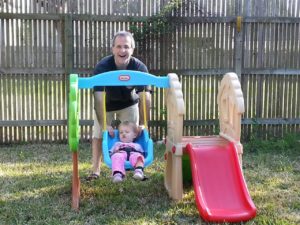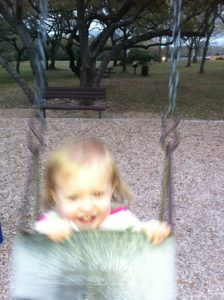The other day, my daughter Colleen said those few words every parent both prays for and dreads: “I can do it myself, Daddy.”
White clouds feathered across a pale blue sky. Under the shade of a sturdy pin oak, I leaned back against the swingset’s stanchion and watched her fling her legs out while she leaned back, then tilt upright and push against the chains, swinging herself back and forth for the first time under her own power.
I should have been happier, I know, and part of me was, but another part of me felt like a veteran third baseman watching a hotshot rookie steal his spot in the lineup. She could do it herself now. What would I do? What would my new playground role be? Sure, I could still play hide-and-seek and chase her around the slide, but what would happen to my encyclopedic knowledge of swing techniques?
Swing Techniques: what do you do when your daughter says she can do it herself? Share on XMy Expertise

Every professional swing-pusher dreads the day when his career is going to come to a close. We all know it’s out there on the horizon, but it’s always tomorrow, or the day after. When it comes, no matter how well prepared we think we are, it’s still a shock.
There were days I pushed Colleen for a half hour or more, regardless of how the sun scorched my ever-growing bald spot. Now, after years of gentle encouragement, subtle hints, and some occasional strong words, my daughter was flying solo.
I had gathered an arsenal of swing techniques: the one-hander, the two-hander, the alternator. What would happen to them? I could clearly see that swing-pushing was becoming a dying art form. The younger generation had no appreciation for this fine art I had devoted so many years to. Why?
As I listened to my daughter laugh, the sweetest sound to fill human ears, I mulled the problem. Here I was with all this information and no one to share it with. It wasn’t right that this art form should die. Someone had to teach the younger generation. At that moment, I knew I had been entrusted with a sacred task.
Here, in this article, for the first time, I’m going to reveal my secret swing-pushing techniques.
The Young Dreamer

You must be wondering how a kid from Rockville Centre, New York grew into one of the world’s top swing-pushers. How did such a storied swing-pushing career begin? Believe it or not, I got my start on the same 6 x 24” EPDM rubber belt swing you did. It may surprise you, but I squeeze into the swing one cheek at a time just like everyone else.
Like most of you, I was a starry-eyed dreamer once, a young swinger back in the days when parents would slide a little metal bar down over the chains to restrain their children. Those were the days. That was when I first experienced the joys of swinging.
My father was always a frustrated swing-pusher: he wanted to make the move into the big leagues, but his other job at the phone company always held him back. He wasn’t able to devote the long hours required to achieve his goals. I, on the other hand, having failed at every career I’ve ever tried, have had no such inhibitions.
After I picked up the preliminaries from Mom and Dad, I took over my own swinging duties. I showed a lot of promise as a pre-teen – a few recruiters even stopped by to check out my technique – but I never got that one break to accelerate my development.
It looked as though I might spend my life in obscurity.
My Pro Career
I left the swings in my twenties. Sure, I should have stopped at seven or eight like most kids, but I was always a late bloomer. Lacking purpose, aim, direction, and a backyard playscape, I wandered for years, unsure where life would take me. Little did I know it would take me back to the Bluegrass Primary Tripod Swing with a 2-3/8” top rail.
Once it did, I found my true calling. I got back to work, and after a few years of perfecting my backward lean, I received a tryout with the Hauppauge High Flyers of the Madawaska Swing Association. From that point forward, I made my name known on the professional circuit.
Most Valuable Swinger: 2000 – 2002
There’s little question that the highlight of my career came during my triple crown years of 2000 – 2002; highest front-swing, highest back-swing, and highest cumulative swing. I received the MVS (Most Valuable Swinger) of the National Swinging League three years in a row.
People don’t toss around the term “legend” too often – and they never did with me – but that never stopped me from using it. My career had acquired legendary status among the playground elite. They called me “Big Kid,” “Slow Boy,” and “Mr. Peculiar,” but I didn’t care. To me, it sounded like the hurrahs of an adoring crowd, and I was perfecting my swing techniques.
The End of an Era

If not for a twisted ankle following a flying dismount, I’m sure I would have nailed a fourth consecutive MVS Award in 2004, but Father Swing was catching up to me. It was time to move on and join the ranks of the swing-pushers.
With the arrival of my little bundle of joy, I put my vast experience on the swingset to work, teaching her the fundamentals of this dynamic and ever-changing sport. She was ready to go off on her own. I knew it. She knew it. I had trained her well, and my time in the spotlight had come to an end.
Swing Techniques: All My Secrets
Now that my career as a swing-pusher has come to a close, for the first time ever I’m going to reveal all the secrets that elevated my swing-pushing game to the next level, the ones that I’m sure can do the same for you. Here, for the first time, are my swing techniques:
- The Chest Pass: the basic move, the starter move, the foundation of greatness. Oh, sure, I know you’re going to want to move on to the more advanced techniques, but a close study of the chest pass will yield fertile fruit. Hold out your two hands, chest high, and push the swing outwards just like a basketball bounce pass. Step into it if you need to, or keep the feet parallel. It’s up to you.
- The One-Hander: mandatory for those days when you want to read about the latest Mets’ bullpen collapse while you push your child.
- The Alternator: your arms need the occasional rest. Alternate one with the other.
- The Double Alternator: conserve energy and wait one swing between pushes. No more than one though; otherwise, the arc of the swing will sink too low and you’ll have to bend at the waist, ruining the perfect form fans applaud.
- The Forward Push: switch sides and let ‘er rip from the front. This is a useful variation until your child gets sick of looking at you.
There you have it: my full array of techniques. Work hard, swing hard.
What’s Next for Me?
As I ride into the sunset of my brilliant swing-pushing career, I’m not sure what the next chapter will be. I have an offer from SPN, the Swing-pushing Network, to work as a reporter, interviewing players during competitions, but what I’d really like to do is give back to the swing-pushing community.
Is there anyone out there that needs some coaching? Let me know. I’m available at a bargain rate.
Michael Ganesan
Great blog.
Robert
Thanks, Michael, I appreciate the kind words.